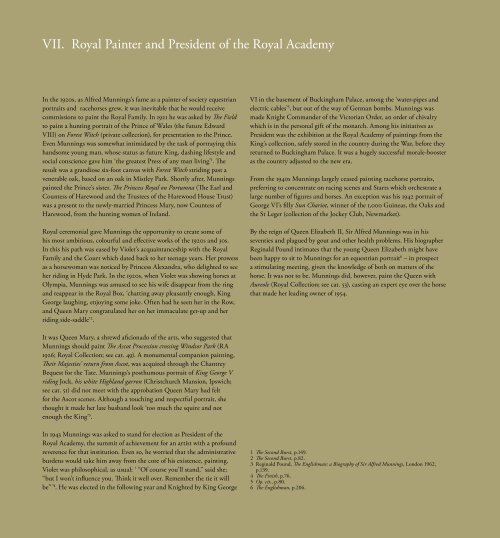An Artist’s Life
Munnings - Richard Green
Munnings - Richard Green
Create successful ePaper yourself
Turn your PDF publications into a flip-book with our unique Google optimized e-Paper software.
VII. Royal Painter and President of the Royal Academy<br />
In the 1920s, as Alfred Munnings’s fame as a painter of society equestrian<br />
portraits and racehorses grew, it was inevitable that he would receive<br />
commissions to paint the Royal Family. In 1921 he was asked by The Field<br />
to paint a hunting portrait of the Prince of Wales (the future Edward<br />
VIII) on Forest Witch (private collection), for presentation to the Prince.<br />
Even Munnings was somewhat intimidated by the task of portraying this<br />
handsome young man, whose status as future King, dashing lifestyle and<br />
social conscience gave him ‘the greatest Press of any man living’ 1 . The<br />
result was a grandiose six-foot canvas with Forest Witch striding past a<br />
venerable oak, based on an oak in Mistley Park. Shortly after, Munnings<br />
painted the Prince’s sister. The Princess Royal on Portumna (The Earl and<br />
Countess of Harewood and the Trustees of the Harewood House Trust)<br />
was a present to the newly-married Princess Mary, now Countess of<br />
Harewood, from the hunting women of Ireland.<br />
Royal ceremonial gave Munnings the opportunity to create some of<br />
his most ambitious, colourful and effective works of the 1920s and 30s.<br />
In this his path was eased by Violet’s acquaintanceship with the Royal<br />
Family and the Court which dated back to her teenage years. Her prowess<br />
as a horsewoman was noticed by Princess Alexandra, who delighted to see<br />
her riding in Hyde Park. In the 1920s, when Violet was showing horses at<br />
Olympia, Munnings was amused to see his wife disappear from the ring<br />
and reappear in the Royal Box, ‘chatting away pleasantly enough, King<br />
George laughing, enjoying some joke. Often had he seen her in the Row,<br />
and Queen Mary congratulated her on her immaculate get-up and her<br />
riding side-saddle’ 2 .<br />
VI in the basement of Buckingham Palace, among the ‘water-pipes and<br />
electric cables’ 5 , but out of the way of German bombs. Munnings was<br />
made Knight Commander of the Victorian Order, an order of chivalry<br />
which is in the personal gift of the monarch. Among his initiatives as<br />
President was the exhibition at the Royal Academy of paintings from the<br />
King’s collection, safely stored in the country during the War, before they<br />
returned to Buckingham Palace. It was a hugely successful morale-booster<br />
as the country adjusted to the new era.<br />
From the 1940s Munnings largely ceased painting racehorse portraits,<br />
preferring to concentrate on racing scenes and Starts which orchestrate a<br />
large number of figures and horses. <strong>An</strong> exception was his 1942 portrait of<br />
George VI’s filly Sun Chariot, winner of the 1,000 Guineas, the Oaks and<br />
the St Leger (collection of the Jockey Club, Newmarket).<br />
By the reign of Queen Elizabeth II, Sir Alfred Munnings was in his<br />
seventies and plagued by gout and other health problems. His biographer<br />
Reginald Pound intimates that the young Queen Elizabeth might have<br />
been happy to sit to Munnings for an equestrian portrait 6 – in prospect<br />
a stimulating meeting, given the knowledge of both on matters of the<br />
horse. It was not to be. Munnings did, however, paint the Queen with<br />
Aureole (Royal Collection; see cat. 53), casting an expert eye over the horse<br />
that made her leading owner of 1954.<br />
It was Queen Mary, a shrewd aficionado of the arts, who suggested that<br />
Munnings should paint The Ascot Procession crossing Windsor Park (RA<br />
1926; Royal Collection; see cat. 49). A monumental companion painting,<br />
Their Majesties’ return from Ascot, was acquired through the Chantrey<br />
Bequest for the Tate. Munnings’s posthumous portrait of King George V<br />
riding Jock, his white Highland garron (Christchurch Mansion, Ipswich;<br />
see cat. 51) did not meet with the approbation Queen Mary had felt<br />
for the Ascot scenes. Although a touching and respectful portrait, she<br />
thought it made her late husband look ‘too much the squire and not<br />
enough the King’ 3 .<br />
In 1943 Munnings was asked to stand for election as President of the<br />
Royal Academy, the summit of achievement for an artist with a profound<br />
reverence for that institution. Even so, he worried that the administrative<br />
burdens would take him away from the core of his existence, painting.<br />
Violet was philosophical, as usual: ‘ “Of course you’ll stand,” said she;<br />
“but I won’t influence you. Think it well over. Remember the tie it will<br />
be” ’ 4 . He was elected in the following year and Knighted by King George<br />
1 The Second Burst, p.149.<br />
2 The Second Burst, p.82.<br />
3 Reginald Pound, The Englishman: a Biography of Sir Alfred Munnings, London 1962,<br />
p.139.<br />
4 The Finish, p.76.<br />
5 Op. cit., p.80.<br />
6 The Englishman, p.206.


